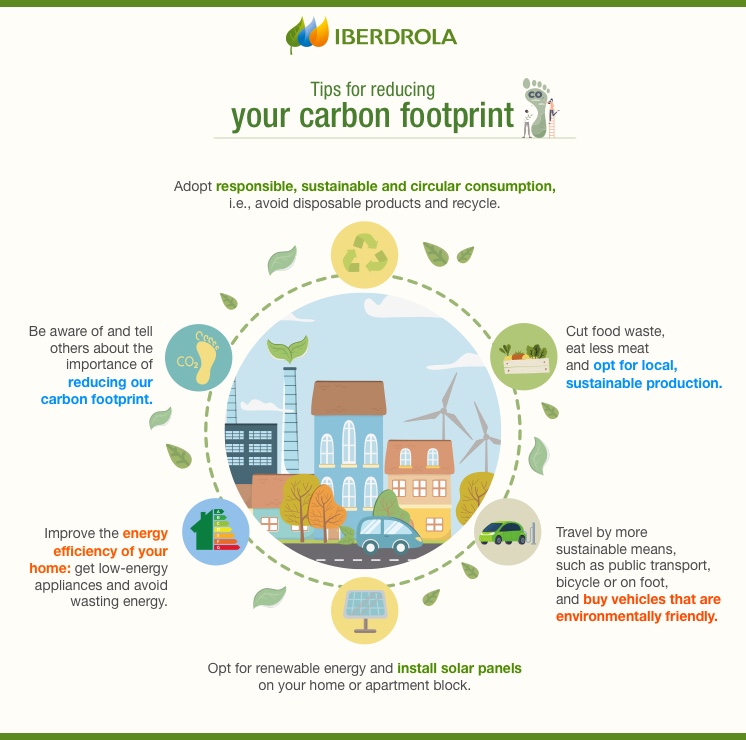Carbon neutrality
Carbon neutrality, what is it and why is it vital for the future of the planet?
At the UN Climate Change Conference in 2015 an agreement was reached (The Paris Agreement): to move towards carbon neutrality by the second half of the 21st Century to mitigate the effects of climate change. Here we take a look at what steps are being taken to reach a balance that is vital for the next generations.

Carbon dioxide (CO2) emissions are one of the main causes of climate change. Since the beginning of the Industrial Revolution, humanity has made increasing use of the carbon trapped inside the so-called fossil fuels, i.e., coal, oil and natural gas, which, when burnt, is released in the form of CO2. In May 2019 its concentration in the atmosphere reached record levels: 415 ppm (parts per million).
CO2, together with other greenhouse gases (GHG), traps in solar radiation and warms the surface of the earth. The effects of global warming in the coming decades may be catastrophic: more frequent, severe droughts, extreme storms and heatwaves, rising sea levels, thawing of glaciers, loss of biodiversity and major upheavals in people's lives, leading even to climate migration.
What is carbon neutrality?
According to the European Parliament, carbon neutrality is reached when the same amount of CO2 is released into the atmosphere as is removed by various means, leaving a zero balance, also known as a zero carbon footprint. But what exactly do we mean by carbon footprint? This is defined as the total amount of GHG emissions caused by an individual, organisation, service or product.
There are a number of ways of achieving the balance we are talking about. The healthiest way is not to emit more CO2 than can be absorbed naturally by the world's forests and plants, which act as carbon sinks through the process of photosynthesis - they take in CO2 from the air and turn it into oxygen - helping to reduce emissions.
In a statement delivered in 2020, UN Secretary-General António Guterres established the key factors involved in reaching climate neutrality:
- Building a true global coalition in support of carbon neutrality by 2050.
- Aligning global finance behind the Paris Agreement and the Sustainable Development Goals (SDGs).
- Making decisive progress on adaptation and resilience to climate change.
"Every country, city, financial institution and company should adopt plans for transitioning to net zero now"
António Guterres, United Nations (UN) Secretary-General
Differences between carbon positive, carbon neutral and carbon negative
After looking at the carbon neutrality, or carbon neutral, we can turn to two related concepts that tend to cause confusion by being used the wrong way round:
- Carbon negative means that an activity goes beyond carbon neutrality by eliminating more CO2 than it emits. Microsoft recently announced that it will be carbon negative by 2030.
- Carbon positive: means that an activity releases more carbon into the atmosphere than it removes or compensates for, producing a negative effect for the planet.
How can we achieve carbon neutrality?
The group of experts on the Intergovernmental Panel on Climate Change (IPCC) claims that it is possible to reach carbon neutrality by 2050 and limit global warming to 1.5°C, but they warn that to achieve this target requires unprecedented social and political change. In a recent communication, the UN indicated where we should be heading in the short term:
- Set a price for carbon emissions that makes it possible to invest in its removal and in the development of low-emission alternatives, such as renewable energy.
- Stop building new coal-powered power stations, which are responsible for a large proportion of the emissions.
- Transfer the carbon tax burden from taxpayers to the polluters.
- Mandate the publication of the economic risks associated with the climate.
- Include the goal of carbon neutrality in countries' financial and fiscal decisions.
On a personal level, every citizen has it in their power to reduce their carbon footprint. This is essential for achieving climate neutrality. Here are some tips:

SEE INFOGRAPHIC: Tips for reducing your carbon footprint [PDF] External link, opens in new window.
The benefits of reaching carbon neutrality
Achieving carbon neutrality is not only the key to avoiding the worst consequences of climate change - it also brings benefits to communities and society as a whole. They include:
Less environmental pollution and improvements to health.
A boost to sustainable economic growth and the creation of green jobs.
Enhanced food security by lessening the impact of climate change.
A halt to the loss of biodiversity and an improvement in the condition of the oceans.
Companies, according to the NGO Carbon Trust, can also benefit directly from carbon neutrality:
It shows the company's commitment to decarbonisation and its desire to compensate for left-over impacts.
It improves the company's green credentials, differentiating it from the rest as an environmentally responsible brand.
They align themselves with the UN SDGs, reducing the risks associated with climate change on a general and private level.
What is PAS 2050 and PAS 2060 certification?
PAS 2050 certification is a recommendation from the UK Department for Environment, Food and Rural Affairs (Defra) and the Carbon Trust, developed together with the British Standards Institution (BSI), that offers companies a standardised way of measuring GHG emissions throughout the manufacturing chain and the useful life of a product or service.
PAS 2060, which is based on the PAS 2050 standard, is the only internationally recognised carbon neutrality standard as it includes more stringent requirements for the measurement, reduction and compensation of GHG emissions for organisations, products and events, thereby providing a system for companies to demonstrate that their actions are real.




